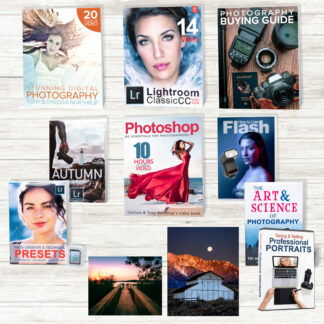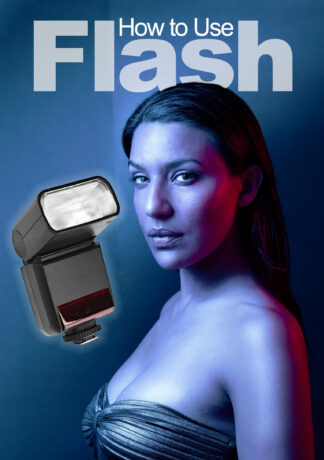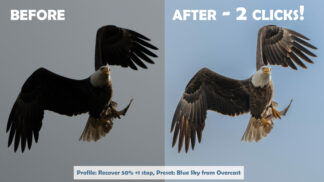Photographing Song Birds
Birds are amazing subjects because of their amazing diversity. Birds have adapted to almost every environment on Earth, and their striking colors (or lack thereof), varying shapes, and complex behaviors are all designed to help them survive. Photographing birds is challenging for many different reasons:
- Birds are small and would rather you not get close to them.
- Birds like to hide in trees, where branches and leaves can ruin your pictures.
- Birds are often photographed against the sky or water, which can confuse your camera’s auto exposure.
- Birds don’t like to pose, but head position and catch lights are vital to taking a good picture.
- Birds can fly, but you cannot.
Photographing Flying Birds
Photographing birds in flight is challenging. Set your camera to shutter priority (Tv or S) with a shutter speed of at least 1/500th. Often, you will need a shutter speed of 1/1000th or 1/2000th to stop motion blur, but it depends on the bird. Start with a slower shutter speed so that you can use a lower ISO and a higher f/stop number, and increase the shutter speed and ISO until you get the head and body of the bird sharp. I prefer to use a shutter speed just fast enough to freeze the head and body but slow enough to blur the wingtips so the bird does not appear frozen in air. Set the autofocus to servo mode so that it continually focuses on the moving subject. Because focus might take several seconds to lock on your subject, start tracking the bird as soon as you can see it, even if it’s too far away to get a decent photo of. If the background is the sky or the water, try enabling all focus points. If the background is land, trees, or buildings, your camera might try to focus on them rather than the bird, and you will get more pictures if you enable only the center focus point. Different cameras and lenses have different capabilities, so finding the ideal combination for different backgrounds and lighting requires experimentation. Anytime you focus on a living thing, you should focus on the nearest eye. That level of precision is impossible with flying birds, however. Often, the camera will focus on the nearest wingtip, and the depth-of-field will be shallow enough that the wing is in focus but the bird’s eye is out-of-focus, ruining the shot. To overcome this, use a higher f/stop number, such as f/8 or f/11. To do this in shutter priority mode, simply increase your ISO. Depending on how bright the sky is, you might end up using ISO 800 or ISO 1600. The higher ISO setting will increase the noise in your picture, but it is more important that you get the eye in focus and keep a shutter speed fast enough to freeze the motion. Use continuous shutter mode to rapidly take as many pictures as possible. I typically take 500 pictures of a single bird in a session just to get one shot that I want to share. Because the exposure can be difficult, and you might need to recover the shadows or highlights to balance the exposure of the bird and the sky, I recommend shooting raw. The large size of raw images can fill your camera’s buffer too quickly, however, preventing you from taking more shots for several seconds while the camera writes the pictures you’ve already taken from the buffer to the memory card. It might also fill up your memory card. Buying a high-speed, large capacity memory card can solve this problem, but they can cost as much as a low-end camera body. If your memory card is causing problems and you don’t want to upgrade, simply switch to JPG. While it’s not ideal, taking large numbers of pictures is more important than capturing each image’s raw data when shooting moving subjects.
Using a Hunting Blind for Wildlife Photography
Hunting blinds are the ultimate camouflage for the stationary photographer. Blinds allow you to get very close to animals, eliminating the need for an expensive telephoto lens. With proper planning, you can use a hunting blind to fill the frame with a 75-300mm lens—even with the smallest birds. Pop-up hunting blinds cost $30-$120, and can fit individuals or up to three photographers with their tripods. They fold up small enough to let you carry them on a short hike, and set up in about 3 minutes. You can buy them online, or at any store that sells hunting supplies. Additionally, you’ll need some camouflage netting that you can hang over the windows in the blind (and over your protruding lens) and a folding stool that you can carry with you. Hunting blinds hide your movement from animals, making them much more effective than simply wearing camouflage. This allows you to relax more than you would be able to while crouched in a bush, enabling you to spend more time in the field. The inside of a hunting blind is black. Therefore, black clothes and a dark hat are more effective than camouflage while inside the blind. Choose a location for your hunting blind with an attractive background, such as a flowering bush. Front lighting is ideal, so find a location in direct sunlight, with the sun in front of the birds (and thus behind you). The lower the sun is in the sky, the more attractive the light. Birds will need a place to perch. If there’s not an ideal perch with a nice background, find a large branch and bury the largest end of it about 6 inches into ground in front of your background. Setting up a perch gives the birds a place to land, and allows you to control the bird’s placement in the light and against the background. Animals in the area will initially be disturbed when you set up a hunting blind. However, birds generally reappear in about ten minutes, and will remain unaware of your presence as long as you’re quiet and you don’t move your camera lens too suddenly. Animals that later come across the hunting blind, such as deer or fox, might not notice the blind at all. When photographing songbirds, I typically set up the blind 6-10 feet away from where I want the birds to perch. For larger animals, set up the blind at a distance that will allow you to almost fill the frame with your subject. When working at close range with small animals such as songbirds, you might need an extension tube to focus closely enough. Extension tubes are hollow tubes that fit between your lens and your camera body, moving the lens farther from your camera’s sensor, thus reducing the minimum focusing distance (and eliminating your ability to focus on far away subjects). A 24mm extension tube with support for autofocus is perfect for most telephoto lenses. For more information about extension tubes, refer to Chapter 12. While the hunting blind is designed to hide your movements, it’s still important to minimize how much you move around. Use a tripod to hold your camera upright with the lens slightly protruding from the blind so that you don’t have to lift your camera when a subject comes into view. Some animals will be scared by the sound of your shutter. Many new cameras support a quiet shutter mode that can help. If your shutter continues to scare animals, you’ll still be able to get one shot—take your time and make sure you have eye contact before you press the shutter. The longer you spend in a hunting blind, the better your results will be. It’s tempting to occupy yourself with a book or smartphone. However, the minute you look away, your subject will appear, and you’ll miss your shot. A better option is to listen to music or an audiobook with a single ear bud, keeping one ear open to listen for animal sounds.
Photographing Insects
We’re all accustomed to seeing, and being annoyed by, insects. When you capture them in a macro photograph, though, you get more insight into their life, activities, and bright colors. In fact, insects might be the most rewarding animals to photograph because they’re brightly colored, plentiful, and accessible. I encourage you to experiment with insect photography using your existing camera equipment. Once you attempt to take some insect pictures, you’ll find that it’s difficult to get close enough and the pictures are often blurry. Solving these problems requires a combination of technique and equipment. For detailed information about macro photography equipment and techniques, read Chapter 12, “Macro.” Focusing on insects is a massive challenge. I use two different approaches:
- Set the lens to autofocus and set the camera to AI servo with the center focusing point. This will cause the camera to attempt to continually keep the subject in focus. Depending on your equipment and the lighting, this might work well or the camera might spend all its time hunting for focus, never finding the subject.
- Set the lens to manual focus, adjust the focus to the minimum focusing distance, and then move the camera toward the subject until it’s in focus. Rather than adjusting the focus ring on your lens, you’ll focus by leaning towards or away from the subject. When the subject is in focus, hold down the shutter and take several pictures.
https://www.youtube.com/watch?v=Hl2AN4vR9a0 Whichever technique you choose, you’ll find that most of your pictures are out of focus—hence the need to take many pictures. Even if the subject is still, you’re not. Because macro photography has an incredibly small depth-of-field and you’ll be hand-holding your camera, you’ll find that your body moves forward and backwards enough to throw your entire subject out of focus. With some patience, you can take amazing insect photos using your existing lens and several inexpensive extension tubes (as described in Chapter 12, “Macro”). The ideal insect photography gear requires a DSLR and the following equipment:
- A telephoto macro lens with a focal length of 100-200mm. I use a Sigma 150mm macro lens, which costs about $1,100.
- A ring flash. Ring flashes mount to the front of your lens so they can light your subject more evenly. If you try to light an insect with a flash mounted over the body of your camera, the light will be very uneven and partially blocked by the lens. Ring flashes cost anywhere from $50 to $500.
You don’t always need a ring flash; if it’s a bright day and you’re shooting a subject that holds still for a few seconds at a time (like a butterfly), set your camera to ISO 800 and shutter priority (Tv or S) with a shutter speed of 1/250th. Using shutter priority will cause your camera to use the aperture with the most depth-of-field possible. Natural light always looks better than a ring flash, but you almost always need a flash to avoid camera or motion blur. If you are using a ring flash, start with your camera set to manual mode (M), ISO 200, a shutter speed of 1/250th, and an aperture of f/11. If the background appears too dark, increase the ISO to 400 or 800. If parts of your subject are not in focus, set the aperture to f/16 or f/22. Notice that the equipment list didn’t include a tripod. As a rule, tripods are a requirement for macro photography—but photographing living insects requires you to constantly re-focus and chase them with the camera, and only hand-holding gives you the flexibility you need.
Stuff that Annoys Wildlife Photographers
Here’s a fun video that wildlife photographers will relate to:





